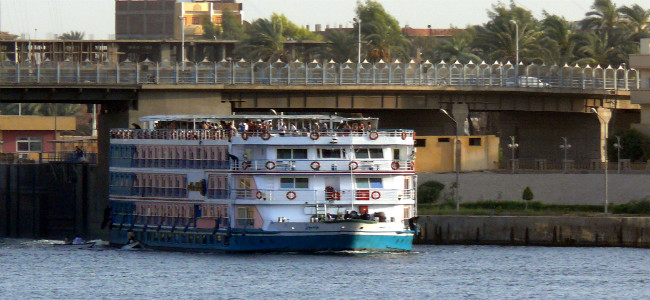Exploring the Esna Lock in Egypt: A Key to Nile River Navigation
Esna Lock was built with an elevation difference of 8 meters, 17 meters wide, 221 meters long, and 14.6 meters deep. The lock's body consists of 7 Joints, 20.6 meters long each. The Lock has two entrances; the front entrance is 32 meters long, while the back entrance is 29.3 meters long. Forty meters depth Diaphragm walls deep been used to construct the Lock, and a bridge was built and rested over the walls.
Esna Lock History
It started during the Ptolemaic era and has been modified and updated over the time. Old Esna lock was built in 1908 during the reign of Khedive Abbas Hilmi II. Then, it was renovated and reopened on January 1 st, 1996.
Esna Lock How it Works?
When a boat enters the lock, the gates are closed behind it, and the water level in the lock is adjusted to match the level of the river downstream. Once the water level is equalized, the gates on the downstream side of the lock are opened, and the boat can continue its journey down the river.
Filling the lock with water and emptying it is carried out through 4 automatic gates, while a control tower loads and opens the lock in about 6 minutes.
Why Was Esna Lock Built?
Esna Lock was constructed to control the flow of Nile water to preserve and store the water for agriculture and to improve navigation in the river Nile. The lock is a vital waterway on the Nile River that connects the upper and lower parts of the river. Esna lock is an essential part of the Nile River transportation system and has played a crucial role in the transportation of goods and people along the Nile River for centuries.
Esna Lock & Nile River Cruise
Esna lock is also a popular destination for tourists who come to see its massive structures and watch boats pass through it. It is also a scenic photo spot for the Nile travelers while crossing on board their Nile cruises onto Edfu coming from Luxor or onto Luxor from Edfu departing from Aswan.
Passing through the Esna Lock is a thrilling experience for Nile cruise passengers. The lock is an engineering marvel, and watching the gates open and close is a sight to behold. Many Nil cruise ships also stop at Esna to allow passengers to explore the town and visit nearby temples and ancient ruins. Whether interested in history, engineering, or just exploring new places, a trip to the Esna Lock and a Nile cruise between Luxor and Aswan should be on your travel bucket list.
Nile cruises Luxor Aswan are a popular way to explore the ancient wonders of Egypt. These cruises typically last for several days and take passengers on a journey down the Nile River. Many of these cruises stop at Esna to allow passengers to see the lock and learn about its history.
Esna Egypt
Esna city is located on the west bank of Egypt River Nile, about 33 miles south of Luxor, The town was formerly part of the modern Qena Governorate. It was the ancient city of Senat, called Latopolis by the Greeks The "city of the fish" where the Nile perch was worshiped.
Today, Esna is a somewhat sleepy if busy merchant and farming town, with a weaving industry, on the west bank of the Nile where the entertainment more resides in the Saturday animal market.
The two main points of interest in Esna are its lively tourist-oriented market, which fills a couple of streets leading inland from the corniche. The other is the temple of Esna. The temple, which has only been partially excavated, is about 200 meters from the river and some 9 meters below street level.
The temple dates back to the Ptolemaic and Roman Period and one of the last temples built in Egypt, stands today in its excavation pit, 9m below the modern ground level. It was dedicated to the god Khnum and several other deities, including Neith, Heka, Satet and Menheyet. The remains of the Temple contain a hall of columns, with 24 pillars, beautifully decorated with lotus and palm capitals.
The walls are covered with 4 rows of relief's, showing Ptolemaic and Roman Emperors dressed in Pharaoh Costumes, sacrificing to the God of the Temple. On both sides of the Temple entrance there are chambers that were used by the priests and keepers of the Temple as storerooms.
Egypt Tours Including Esna Lock
| Tour | Itinerary | Price |
|---|---|---|
| Nour El Nil | 6 Days | $ 3450 |
| Amoura Dahabiya | 5 Days | $ 1505 |
| Merit Dahabiya | 5 Days | $ 1699 |
| Ms Donia Dahabiya | 6 Days | $ 1940 |
| Nebyt Dahabiya | 5 Days | $ 2674 |
| Nuun and Nuut Dahabiya | 4 Days | $ 1157 |
| Eyaru Dahabiya | 8 Days | $ 9910 |
| Nile Cruise Cairo to Luxor | 13 Days | $ 6337 |
| Nile Cruise Cairo to Aswan | 15 Days | $ 7950 |
| Historia Nile Cruise | 4-5 Days | $ 1709 |
| Jaz Crown Jubilee | 4-5 Days | $ 627 |
| Iberotel Crown Empress | 4-5 Days | $ 649 |
| Oberoi Zahra Nile Cruise | 8 Days | $ 5749 |
| Ms Esplanade Nile Cruise | 4-5 Days | $ 825 |
| Ms Salacia Nile Cruise | 4-5 Days | $ 709 |

